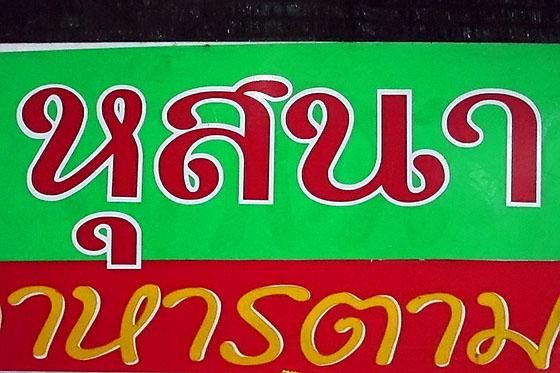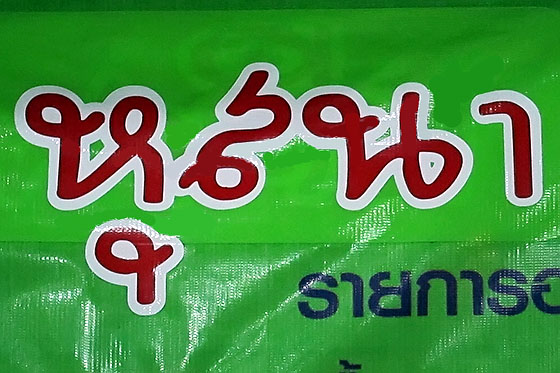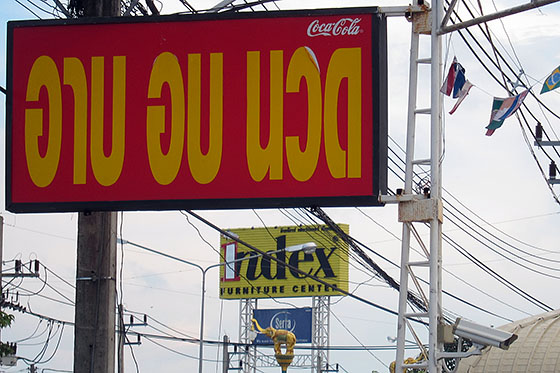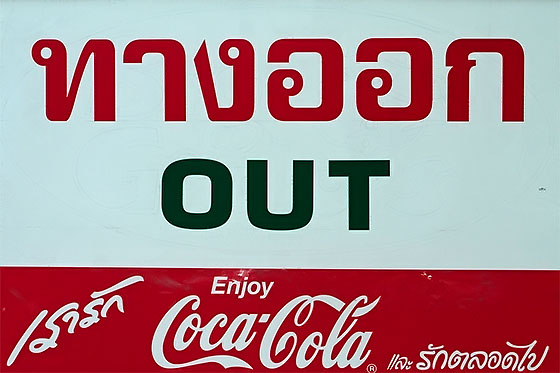Learn How To Read Thai - Tutorial 10
Tones
When I talk about tones you may not understand what I mean if you haven't heard native Thai speakers. What are tones?
In English we use tones to convey emotion, mood and feeling. The difference with Thai is that tones actually change the meaning of similar sounding words - as we have seen in previous tutorials. I have done this before somewhere but let's take another look at the tones.
Low tone. In English we might use a low tone for emphasis, or if we are angry. If someone asks you a yes/no question which makes you angry, the tone of your reply will probably be quite low.
High tone. As English speakers, our tone might go high if we are surprised. "Really?" or "What?" might be spoken in a high tone if we are surprised.
Falling tone. Imagine calling someone's name from a distance to get their attention. The tone starts quite high but as you continue voicing their name, the tone falls.
Rising tone. Australians tend to use a rising inflection when they speak so the tone of their sentences rises. A rhetorical question indicating surprise might rise in pitch, "He said what?" Irritation can also lead to rising tones, "I know!"
Mid tone. This is just normal speech with no emotion.
'S' Consonants
There are four Thai consonants that make an 'S' sound. One is very common; one is fairly common; but the other two are quite rare. Most Thai characters can be written with one stroke of the pen but three of the 'S' characters can't. This makes them quite easy to spot.
Why are there three high-class 'S' consonants that all perform exactly the same function? I don't know is the answer, but there are. As I said, one is commonly used and the other two aren't but they are still in use and not obsolete so you need to know them.
The other one (Sor Soh) is quite similar to another character that we haven't covered yet (Chor Chaang). The only difference is an extra notch. Be careful with characters that have a similar appearance.
As if having four 'S' consonants isn't enough, there is a Thai consonant cluster that logically should make a 'TR' sound, but it also makes an 'S' sound. This sounds a bit weird but it's probably no weirder than English consonant clusters that make sounds unrelated to the individual consonants.
For example, the Thai word for 'sand' uses this consonant cluster.
ทราย = saay (a long 'ai' vowel sound; the Thai word for sand)
The following is a summary of the Thai consonants that make an 'S' sound:
ส
Name in Thai: ส เสือ
Name in English: Sor Seua (tiger)
Initial: s
Final: t
Class: High
Usage: Very common
Writing practice: Download Worksheet
Comments: This consonant looks like lor ling but with an extra stroke. It is very common and needs to be remembered. I can't think of much to say about 's' characters apart from the fact they are all pronounced as 't' when used as final consonants.
ซ
Name in Thai: ซ โซ่
Name in English: Sor Soh (chain)
Initial: s
Final: t
Class: Low
Usage: Fairly common
Writing practice: Download Worksheet
Comments: This 's' character isn't as common as the one above but it does appear fairly regularly and needs to be remembered.
ศ
Name in Thai: ศ ศาลา
Name in English: Sor Saalaa (pavilion)
Initial: s
Final: t
Class: High
Usage: Rare
Writing practice: Download Worksheet
Comments: This consonant looks like Kor Kwaay but with an extra stroke. It's rare and isn't seen very often. As I said above, three of the 's' characters look like other commonly used characters apart from an extra stroke. They are therefore easy to spot and easy to remember.
ษ
Name in Thai: ษ ฤๅษี
Name in English: Sor Ruesee (hermit)
Initial: s
Final: t
Class: High
Usage: Rare
Writing practice: Download Worksheet
Comments: This consonant looks like bor bai mai but with an extra stroke. The Thai script used to write the name of this character is so weird that I can't read it! The Thai word for English/England uses this as a final consonant but it is rarely seen.
Reading Practice
Now let's combine some of these new consonants with previously learnt consonants and vowels to make new words.
สั่ง
The first consonant is the common 's' consonant that we learnt today. It is followed by mai-hun-aagaat (Tutorial 2) and ends with the 'ng' character (Tutorial 4) as a final consonant. You will also notice the first tone mark above mai-hun-aagaat.
The word sung is the Thai verb 'to order', as in food. About 30 minutes before writing this I was asked in a restaurant if I had ordered yet and this word was used.
Tone: High-class initial consonant and first tone mark = Low tone (Tutorial 14)
ซ้าย
The first consonant is another 's' sound we covered today. It is followed by the long 'aa' vowel (Tutorial 7) and yor yuk (Tutorial 7). The word saay means 'left' in Thai, as opposed to right. Together with the verb 'to turn' you use this word to give directions.
Tone: Low-class initial consonant and second tone mark = High tone (Tutorial 14)
See if you can pick out this word in the sign below:

สะอาด
If you are following these tutorials as I had intended, you will have spotted sara uh (Tutorial 2) and identified that this word has two syllables. The first consonant is sor seua followed by sara uh to give suh.
The next syllable begins with a long 'aa' sound (Tutorial 7) but when writing Thai words or syllables that begin with a vowel sound we must write the zero consonant before the vowel (Tutorial 11).
The reason for this is that some vowels are written over or under the preceding consonant and therefore we need a consonant in order to be able to write the vowel. If the syllable starts with a vowel sound we still need a physical consonant but we don't want it to make a sound, hence the zero consonant.
After the zero consonant comes the long 'aa' vowel and the final consonant is dor dek which becomes an unreleased 't' sound when used as a final consonant.
The Thai word suh-aat means 'clean'.
Tone first syllable: According to the tone rules this is a low-tone but in normal, everyday speech the first syllable of poly-syllabic words is pronounced with a mid-tone.
Tone second syllable: Mid-class initial consonant, dead syllable, long vowel = Low tone (Tutorial 14)
สวน
The initial consonant is the commonly used 's' character. It is followed by wor wairn in a mid-position which makes an 'oo-uh' sound (Tutorial 9) and the final character is nor noo (Tutorial 8).
The Thai word soo-un can mean several different things in English such as garden, park, plantation, orchard.
Tone: High-class initial consonant, live syllable = Rising tone (Tutorial 14)
When I first started attempting to read Thai in the real world, there were a number of characters that I just couldn't recognise because the fonts used didn't look like anything from my text books or learning materials.
The way that Sor Seua is often written is a good example. Take a look at the following two signs from the same restaurant. The quality of the photos isn't good, but the photos are of real signs and the quality of the signs wasn't good either.
Pay attention to the way Sor Seua is written. One version looks fairly standard but the other is nothing like it. However, this unusual version appears often.
The word in the example sounds something like huu sanaa.
According to some scientists this is actually a good thing because 'difficult-to-read fonts make for better learning'
First, the standard version:

Now, take a look at this one:

หุสนา
ซัก
The initial consonant is the second most common 's' consonant. It is followed by mai-hun-aagaat (Tutorial 2) and ends with gor gai which, as a final consonant, makes an unreleased 'k' sound (Tutorial 1).
The Thai word suk means to clean/wash but be aware that Thai has differents verbs 'to clean/wash' depending on what is being cleaned or washed. This verb is normally used when talking about washing clothes.
Tone: Low-class initial consonant, dead syllable, short vowel = High tone (Tutorial 14)
Next is a short three word phrase that is related to this word.
ซัก อบ รีด
The first word is the same as above.
The second word has two letters. First the zero consonant and then bor bai mai (Tutorial 3) which, as a final consonant makes an unreleased 'p' sound. The word is op and means 'to bake' or 'to treat with heat'. For example, this word is used to describe baked food.
Tone: Mid-class initial consonant, dead syllable, short vowel = Low tone (Tutorial 14)
The third word begins with ror reua (Tutorial 2). Above ror reua is the long 'ee' vowel (Tutorial 3) and the final consonant is dor dek (Tutorial 6) which, as a final consonant, makes an unreleased 't' sound. The Thai word reet means to iron.
Tone: Low-class initial consonant, dead syllable, long vowel = Falling tone (Tutorial 14)
You will see this written outside places offering a laundry service. Click to see a real-life example (link opens pop-up image) of a sign that uses this phrase. This will also give you practice at reading real-life Thai fonts.
Here's another useful sign if you're a litle frail and need some assistance while taking a bath:
อาบ อบ นวด
aap op nuat

If you can read and understand this, you are making good progress! If not, send me an e-mail.
Questions And Feedback
If you have any comments, questions or suggestions, feel free to contact me. Your feedback will help me to improve these pages.
Recommended Books
Amazon UK
Amazon UK
Amazon US
Amazon US

